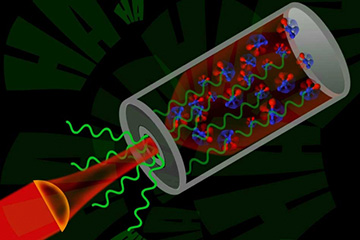
A laser the size of a shoebox produces THz waves (in green) by using a quantum cascade laser (red) to excite and rotate nitrous oxide molecules packed inside a 15cm-long cavity. [Image: Chad Scales, U.S. Army Futures Command]
Scientists in the U.S. have dusted off and updated plans for a gas laser that can generate beams in the elusive terahertz (THz) frequency band. By pumping nitrous oxide (laughing gas) with a quantum cascade laser, they have shown it is possible to produce a broad spectrum of THz radiation using a compact device operating at room temperature (Science, doi: 10.1126/science.aay8683).
Among the applications of such radiation, they say, are sensing, imaging and communication.
Terahertz: Applications and limitations
THz radiation sits in the electromagnetic spectrum between microwaves at lower frequencies and infrared waves above. The fact that it passes through many common materials, such as clothing, plastic and paper, while not having the energy to ionize and therefore harm living tissue, means it is potentially well-suited as a scanning technology. At the same time, its absorption by certain substances at well-defined frequencies suggests its use as a sensor of atmospheric gases.
In addition, THz waves could be used for wireless communication. Not only could they accommodate higher bandwidths than lower-frequency radio waves, their relatively short range could also be exploited to prevent eavesdropping—with the amount of atmospheric absorption depending on the precise frequency used.
Unfortunately, however, building suitable THz sources has proved difficult. There are a number of different technologies on the market—such as those that multiply harmonics of microwaves or mix the output of lasers—but each has its own limitations. None has a significant output around 1 THz, while many are bulky and expensive.
In recent years, researchers have started to make THz sources from quantum cascade lasers (QCLs), whose alternating layers of high- and low-bandgap semiconductor create quantum wells that force electrons to emit a series of photons at specific wavelengths. Such lasers are chip-based, making them potentially small and cheap, but they need to be cooled, are inefficient and cover a limited frequency range.
Exploiting vibrational states
In contrast, the latest work uses a QCL as a pump, rather than as the lasing medium itself. The laser in this case consists of a gas of nitrous oxide, the molecules of which when pumped vibrate and then move into specific rotational states. Held in a suitable cavity, the molecules emit THz photons in the form of a laser beam when dropping back down from one rotational state to another.
In previous decades, cavities several meters long were pumped by large carbon-dioxide lasers. Theoretical models predicted that if the cavity were too small, and the pressure of the gas too high, collisions between gas molecules would prevent the build-up of energy necessary for a population inversion.
Henry Everitt of Duke University, NC, developed a model in the 1980s showing it should in fact be possible to build such compact molecular lasers. However, that model still involved a carbon-dioxide laser as the pump. It was only after working on the theory for a number of years, in collaboration with Steven Johnson and colleagues at the Massachusetts Institute of Technology, MA, he says, did it become clear that a QCL could also pack enough power to make the gas lase.
The trick, according to Johnson, lay in considering vibrational states of the molecules that had been previously overlooked. By limiting energy dissipation when pressure in the cavity is high, he explains in a press release accompanying the research, those vibrations “sort of give you more breathing room to keep rotating and keep making THz waves.”
Lasing with laughing gas
Exploiting that insight, Everitt, who now works for the U.S. Army, teamed up with Federico Capasso and colleagues at Harvard University, MA. Capasso co-invented QCLs while at Bell Labs in the 1990s, and his group has now used an infrared QCL to pump a gas-filled copper tube just 15 centimeters long and 5 millimeters in diameter.
Using nitrous oxide, the researchers showed that the gas lased. What’s more, they found that the frequency of that laser beam varied as they tuned the QCL. They were able to produce 37 lines, each with a width of just a few kilohertz, across the spectrum from 0.25 to 0.96 THz. They also used modeling to show that many other gases pumped in this way—each being paired to its own QCL—should produce laser lines spanning more than 1 THz.
According to Capasso, the device outperforms all existing laser sources in this region of the spectrum—something, he adds, that could not have been predicted with any confidence when he and his colleagues embarked on the research. “It was not obvious that pumping with a broadly tunable mid-infrared QCL was the way to get broadband THz lasing in a gas,” he says.
But Capasso notes that there are still hurdles to overcome before the technology can be commercialized and made ready for real-world applications. Among these, he says, are optimizing the cavity to boost power output as well as changing the gas to carbon monoxide in order to expand the laser’s range up a few THz.
